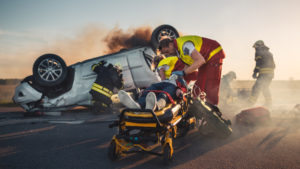In the case of City of Boulder Fire Department v. Industrial Claim Appeals Office, the Court of Appeals of Colorado Division 1 ruled on a workers’ compensation case involving a firefighter who developed cancer.
The procedural history of this case dates back to 2015 after the firefighter was diagnosed with tongue cancer. Two years prior, the claimant had retired after working as a firefighter for 35 years. After his diagnosis in 2015, the firefighter filed for workers’ compensation benefits. In Colorado, firefighters stricken with cancer can receive compensation if they meet certain criteria (Ch. 245, sec. 1, § 8-41-209, 2007 Colo. Sess. Laws 962-63). Under subsections 209(2)(b), employers can challenge this presumption if they can show that a firefighter’s cancer was not caused by his or her job duties (overcoming a 209 presumption).
The City of Boulder challenged this firefighter’s workers’ compensation claim on the grounds that his cancer could have been caused by the sexually-transmitted human papillomavirus (HPV). A biopsy of the firefighter’s tongue tested positive for the virus, which is known to cause oral cancers. The City of Boulder retained a medical expert who testified that the cause of the firefighter’s cancer was likely HPV and not smoke exposure. Another doctor echoed this assessment.
In response to the testimony, the firefighter offered the testimony of a doctor who claimed that the combination of smoke exposure and HPV significantly increased his risk of cancer. The firefighter’s treating doctor agreed with this assessment. While the judge agreed that the cancer and HPV shared a relationship, it was uncertain as to whether the firefighter’s exposure to carcinogens on the job could have also contributed. Due to this uncertainty, the judge concluded that the City of Boulder could not show that it was more likely than not that the firefighter’s employment did not cause his cancer. Bound by the judge’s findings, the panel also rejected the City’s argument, siding with the firefighter.
After the decision, the City of Boulder appealed on the grounds that it showed it was more likely (by the preponderance of evidence) that HPV, a nonoccupational risk-factor, caused the firefighter’s cancer than other risks. According to the City, prior cases require administrative law judges to weigh and rank these risk factors to determine whether a nonoccupational risk-factor was a greater risk in the development of cancer. The City contends the judge and panel made a reversable error when they determined the firefighter’s cancer was compensable due to being multifactorial.
However, the appeals court disagreed with this argument, saying that prior case law does not mandate administrative law judges to rank firefighters’ cancer risks. Furthermore, the appeals court contends that prior case law does not prevent administrative law judges from considering multifactorial causes of cancer. The appeals court determined that although an employer can overcome a 209 presumption by showing the presence nonoccupational risk factors, it does not necessarily mean they will. An administrative law judge will review the evidence and decide whether an employer sufficiently overcame the presumption.
The court also determined that the City of Boulder’s interpretation of subsection 209(2)(b) would make it close to impossible for cancer-stricken firefighters to recover compensation. This is because a firefighter would have to show that the cancer risks associated with firefighting outweighed all other possible cancer risks. Adopting this rule would also conflict with the Supreme Court of Colorado’s mandate to defer to the administrative judge’s findings when they are supported by substantial evidence in the record. In this case, the evidence sufficiently supported the judge’s findings. Therefore, based on the circumstances of the case, the appeals court affirmed the order of the panel and administrative judge to award the firefighter compensation.

Nationally recognized litigation attorney Thomas Metier practice areas include traumatic brain injuries, spinal cord injuries, trucking accidents and motor vehicle accidents. He is licensed to practice in Colorado, Wyoming, the U.S. District Court–District of Colorado, and the U.S. District Court–District of Wyoming, the 10th Circuit Court of Appeals and the U.S. Supreme Court.













Comments for this article are closed.